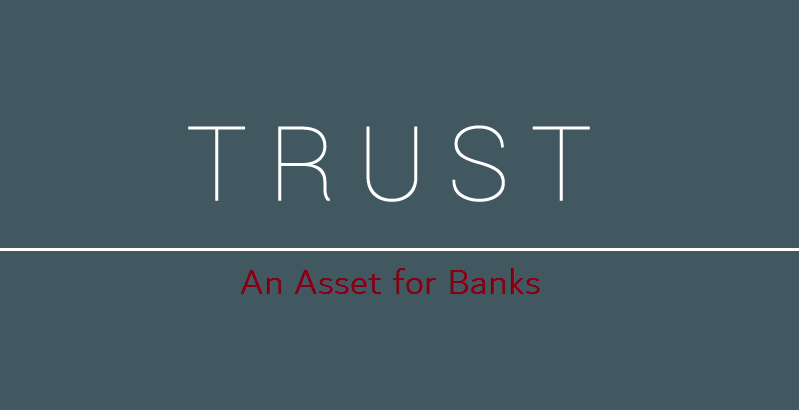
Do customers bank on regulations, competence or reputation? Customers bank on TRUST. Trust is at the heart of banking, but Edelman research report 2019 shows a global decline in trust in institutions. Financial crisis, cyber attacks, data breach and money laundering kind of incidences have given a big blow to the most important asset of the banks and lower down the confidence of their customers. Challenge for the century old banking and financial institutions as well recently popular flock of Fintechs (Challenger Banks / NeoBanks) is how to keep the TRUST of their customers intact and how to ensure people rely on them to keep not just their money and savings safe, but also their information secure and protected?
Open and transparent banking to fulfill the expectations of the customers is the need of the hour.
Being seen as trustworthy has long-term benefits for the banking and financial institutions. Proactively engaging with customers, providing them with necessary new “tech tools” to properly manage their money and protect themselves from frauds, cyber thefts can help to ensure a long-term, profitable financial relationship.
1. Transparency is MUST: Banks must very clearly communicate to their customers what services they provide, what the costs will be, and how they truly serve their best interest. All the essential information should be in a straightforward, simple, and easy to understand manner, so customers can then make their own decisions on how to achieve their goals. If customers do not feel the bank is being transparent about its fees, they are less likely to recommend the bank to others.
2. Technological Advancement: Technology helps to compete. Be innovative. Be Creative. Design a high-quality, consistent, easy to navigate, reliable customer experience. Following years of high-tech disruption across the industry, the ability to adopt and strategically leverage the benefits of new technologies on behalf of customers has become very crucial. Customers are always looking for easy and more efficient tools from their banks to access the banking services. Use robotics, chatbots to give customers personalized advice automatically. AI and big data analytics can increase transparency to get smarter results and better data, and in the end, this will help customers to make wiser and smarter decisions.
3. Data and Privacy: The banking and financial services industry has always been data intense. Plan should be to become an even more data-driven company. That means transformation. Engage in new partnerships, new alliances. Be bold to protect customer data and defend against cybersecurity threats. It is not simply a matter of establishing infrastructure, processes and procedures to prevent attacks or data breaches or illegal access to bank accounts or cards information, but educating, engaging with customers to create products and services that strike a balance between convenience and security.
4. Customer Centric Approach: Customers are highly demanding and have plenty of choices now. Develop a customer-centric culture in the banks by setting the right ecosystem and communication from the top. Long-lasting, trusted relationships cannot be built on merely a series of trust projects. A set of clearly eloquent and continually reinforced values and principles, as well as incentives that motivate and reward the right behaviors, is necessary in order to build customer-centric and trust-driven cultures.
5. Expertise, Unbiased and High Quality Advice: Customers still prefer working with real people, trusted experts than using the latest technology when it comes to making decisions on investment, dispute settlement or purchasing any financial product. Banks that combine the two and deliver the best combination of advice and service to their customers will not only earn trust, but also build a more sustainable business for the long-term.
Allow human common sense, unbiased, high quality advice to be part of the equation, and to never take it out.
6. Credible Information: Customers view content and information shared by their banks as credible. Also customers look to the brands they work with to share insights on issues that impact investors and the industry. A growing opportunity for financial services brands is to establish themselves as thought leaders that provide vital guidance on the issues that most concern their target customers.
7. Frictionless Processes: Understand every customer touch points by removing errors, streamlining service and driving operational excellence. Efficient processes and customer access to information will provide banks more freedom and flexibility to redesign and optimize their branches, digital channels and platforms to align with current and future customer demands.
Future is bright ahead especially for organisations that seize the opportunity to strengthen trust with customers and cultivate trusted brands as a way to differentiate themselves from both new and existing competitors. Trust has tremendous financial benefits and remains the single most valuable currency in the global business environment. The banks that can instill TRUST across all stakeholders will be best positioned to lead in their industries and the ecosystem they work in toward a more prosperous future.
The author Raj Grover is a strategic consultant working with corporate, government bodies, and startups across the globe. He formulates strategies, policies and planning, structure and road map, works on innovative ideas, new product development and has access to disruptive technologies. His customized workshops and training sessions help the leadership and teams in adapting a clear vision for their digital transformation journey.
He is the founder of Transform Partner, the digital transformation consultancy based in UK and India. He can be reached at: raj(at)transformpartner.com

Comments